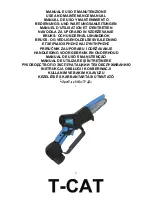
10 ENGLISH
For tool with the inner flange for other
than 15.88 mm hole-diameter saw blade
►
Fig.16:
1.
Mounting shaft
2.
Inner flange
3.
Saw
blade
4.
Outer flange
5.
Hex bolt
The inner flange has a certain diameter protrusion on
one side of it and a different diameter protrusion on the
other side. Choose a correct side on which protrusion
fits into the saw blade hole perfectly.
Next, mount the inner flange onto the mounting shaft
so that the correct side of protrusion on the inner flange
faces outward and then place saw blade and outer flange.
BE SURE TO TIGHTEN THE HEX BOLT CLOCKWISE
SECURELY.
CAUTION:
•
Make sure that the protrusion "a" on the
inner flange that is positioned outside
fits into the saw blade hole "a" perfectly.
Mounting the blade on the wrong side can result
in the dangerous vibration.
►
Fig.17:
1.
Ring
2.
Inner flange
3.
Saw blade
4.
Outer flange
5.
Hex bolt
When changing blade, make sure to also clean upper
and lower blade guards of accumulated sawdust. Such
efforts do not, however, replace the need to check lower
guard operation before each use.
Hex wrench storage
►
Fig.18:
1.
Hex wrench
When not in use, store the hex wrench as shown in the
figure to keep it from being lost.
Connecting a vacuum cleaner
►
Fig.19:
1.
Dust nozzle
2.
Screw
►
Fig.20:
1.
Vacuum cleaner
2.
Hose
When you wish to perform clean cutting operation,
connect a Makita vacuum cleaner to your tool. Install
the dust nozzle on the tool using the screw. Then con-
nect a hose of the vacuum cleaner to the dust nozzle as
shown in the figure.
OPERATION
CAUTION:
•
Be sure to move the tool forward in a straight
line gently. Forcing or twisting the tool will result
in overheating the motor and dangerous kick-
back, possibly causing severe injury.
•
Always use a front grip and rear handle and
firmly hold the tool by both front grip and rear
handle during operations.
Hold the tool firmly. The tool is provided with both a front
grip and rear handle. Use both to best grasp the tool. If
both hands are holding saw, they cannot be cut by the
blade. Set the base on the workpiece to be cut without
the blade making any contact. Then turn the tool on and
wait until the blade attains full speed. Now simply move
the tool forward over the workpiece surface, keeping it flat
and advancing smoothly until the sawing is completed.
To get clean cuts, keep your sawing line straight and
your speed of advance uniform. If the cut fails to prop-
erly follow your intended cut line, do not attempt to turn
or force the tool back to the cut line. Doing so may bind
the blade and lead to dangerous kickback and possible
serious injury. Release switch, wait for blade to stop
and then withdraw tool. Realign tool on new cut line,
and start cut again. Attempt to avoid positioning which
exposes operator to chips and wood dust being ejected
from saw. Use eye protection to help avoid injury.
►
Fig.21
Rip fence (Guide rule)
►
Fig.22:
1.
Clamp lever
2.
Rip fence (Guide rule)
The handy rip fence allows you to do extra-accurate
straight cuts. Simply slide the rip fence up snugly
against the side of the workpiece and secure it in posi-
tion with the clamp lever on the front of the base. It also
makes repeated cuts of uniform width possible.
MAINTENANCE
CAUTION:
•
Always be sure that the tool is switched off and
unplugged before attempting to perform inspec
-
tion or maintenance.
•
Clean out the guard to ensure there is no
accumulated sawdust and chips which
may impede the operation of the guarding
system.
A dirty guarding system may limit the
proper operation which could result in serious
personal injury. The most effective way to
accomplish this cleaning is with compressed air.
If the dust is being blown out of the guard,
be sure the proper eye and breathing protec-
tion is used.
•
Never use gasoline, benzine, thinner, alcohol
or the like. Discoloration, deformation or cracks
may result.
Adjusting for accuracy of 0° and 45°
cut (vertical and 45° cut)
►
Fig.23:
1.
Adjusting screw for 0°
2.
Adjusting screw
for 45°
►
Fig.24:
1.
Triangular rule
This adjustment has been made at the factory. But if it is
off, adjust the adjusting screws with a hex wrench while
inspecting 0° or 45° the blade with the base using a
triangular rule or square rule, etc.
Adjusting for parallelism
►
Fig.25:
1.
Base
2.
Screw
3.
Saw blade
The parallelism between the blade and the base has
been factory adjusted. But if it is off, you can adjust it as
the following procedure.
Make sure all levers and screws are tightened. Slightly
loosen the screw as illustrated. While opening the lower
guard, move the rear of base so that the distance A and
B are equal. After adjusting, tighten the screw. Make a
test cut to get a correct parallelism.











































